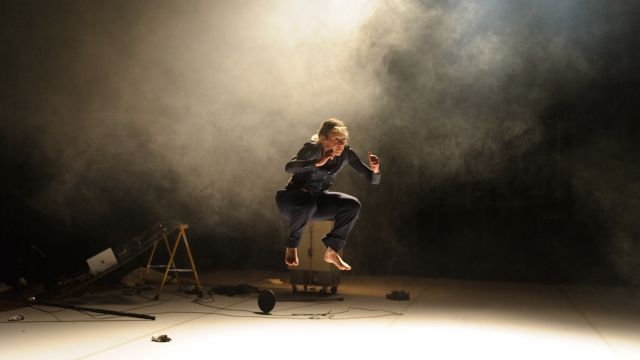Slip
Split is a not an ‘easy’ show: difficult to describe, even more difficult to sum up. The creator is Rebecca Jensen. The show is both abstract and concrete; it reaches for wider meaning and it mixes in down-to-earth comedy and slapstick. It is about sound and images and movement. Jensen says in her program note, ‘Sound and movement separate, loop and return to each other, asking us to be attentive to new ways of seeing and relating to our environments, amplifying what is less perceptible.’ Split is then about paying attention – to everything.

What is on stage – at first – looks like the equipment for a ‘foley’ session – that is, post-production sound effects (SFX) added to a movie or television show. (Design by Romanie Harper.) Obviously, these effects add ‘reality’ by being totally in sync with what’s already been filmed. The foley artist creates sounds to be dubbed onto the soundtrack: footsteps – on boards, on gravel, on cement, etc. – or water pouring into a vessel, or the rustle of clothing as someone sits or stands. Here, behind the recording panel desk, is a foley artist (Aviva Endean), very serious, intent on the task, but who will become collaborator, antagonist and foil – and comedian. The human/dancer literally crashes onto the stage in ‘period costume’ – as if dropped into this world without choice. Throughout, costume changes indicate the passage of time, but the juxtaposition of sound versus movement continues. Now the foley artist proceeds to make sounds in sync with the dancer’s movements.

The sounds the foley artist makes must be ‘in sync’ with the images: that’s the point. What if they weren’t? We begin with the thought that they are – as the performer performs and then collaborates – but then sound and movement become separate, bounce off each other, fight each other. At times it is as if sound is a controlling force that must be resisted.
At one point, a huge screen is revealed. On it, animated liquid figures dance mechanically, repeating the same movements over and over. (This is the brilliant work of Lana Sprajcer.) Jensen dances in sync with these figures – and then she doesn’t. Again, the motif of ‘split’ – in sync, then not, then in.

However you may choose to describe Split, it is riveting, it is engrossing and curiously moving. We witness a struggle. You cannot take your eyes off Jensen who expresses all she has to say through movement – and costume – with sound. She is surrounded by sound – or noise. She might be at one or resistant. We are held because we have no idea what will happen next – and yet Split is focussed and purposeful. It is not a show that ‘develops’ – or not obviously; there is no narrative. It is more a matter of variations on a theme, or an idea that builds.
Although all that’s here is intended, I confess that there are elements that escaped me completely – such as a suspended sack that Jensen punctures, allowing a stream of sand to pour down into the stage. But there are also elements of complete clarity such as when Jensen and Endean together destroy the foley mixing desk – but record the destruction.

Split offers us extended dance sequences in which Jensen combines or segues between dance styles across time: her body is full of life - ecstatic then anguished as if escaping then recaptured. (The Companion, a trained dancer herself, says at the end, ‘She is a superb dancer.’) Significantly, Jensen comes to rest with Saint-Saens’ music and an hommage to Pavlova’s iconic The Dying Swan – a perfect fusion of sound and movement.
Michael Brindley
Photographer: Sarah Walker
Subscribe to our E-Newsletter, buy our latest print edition or find a Performing Arts book at Book Nook.

